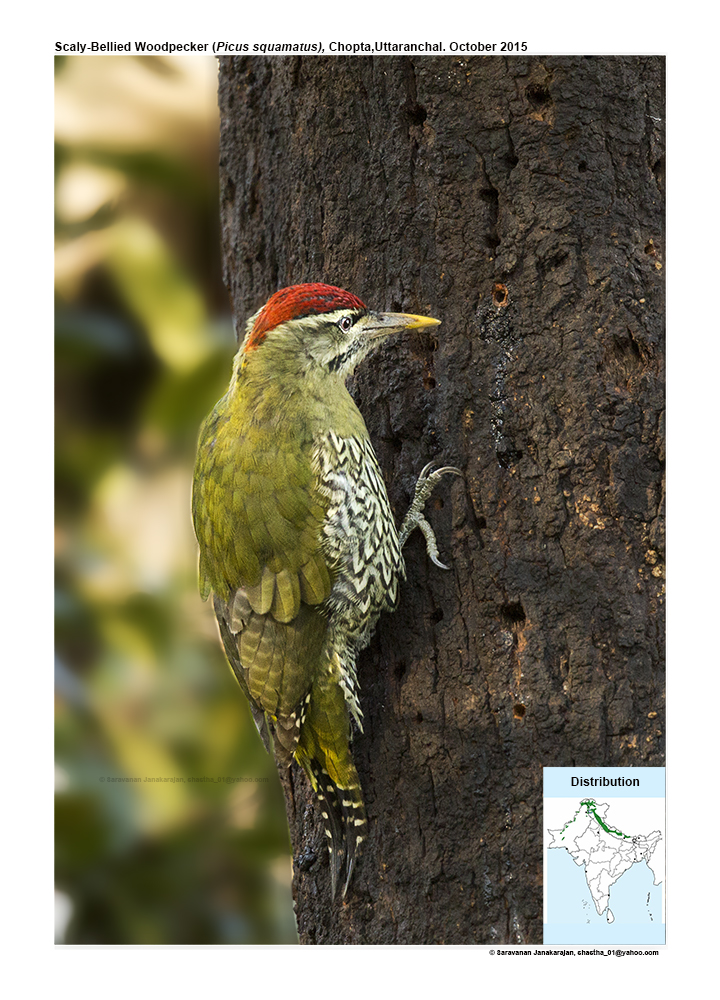Scaly-bellied Woodpecker

Scaly-bellied Woodpecker Picus squamatus
Etymology:
- Picus : Latin word for Woodpecker; Greek Mythology Picus, king of Latium, who married the beautiful nymph and songstress Canens and was changed into a woodpecker by the spiteful Circe, whose affections he had spurned.
- Squamatus: Latin word for “ scaled” derived from squama – scale
Vernacular Names: Kash: Koel makots, H.P: Tuktola, Mal: Maramkotti, Sinh: Kerella
Distribution in India: Resident of Western and central Himalayas in India.
Description: Size of 35 cm; wt. of 156–194 g. The male has red forehead, crown and nape, usually some dark feather bases showing through, orangey in narrow wedge down hindneck. It has black upper lores and narrow line along crown side, white supercilium from above eye to side of nape, narrow black eyestripe. The lower lores are yellowish-white, cheeks and ear-coverts are olive-grey, greener or yellower on neck side. It has a black malar stripe that is streaked whitish; olive chin, throat and breast, variably grey-tinged; green upperparts, yellow on rump and uppertail-coverts, latter with green bases. The flight-feathers and primary coverts are blackish-brown, secondaries and tertials are with green outer webs, all barred whitish. The uppertail is dark brown, barred buff-white, strong green suffusion on outer feathers; lower breast and belly are greyish-white, tinged greenish, feathers with broad black submarginal lines producing strong scaly appearance, usually also thin black shaft streaks. The underwing is barred brown and white, coverts are yellowish. The undertail is like upperparts but paler with yellowish barring; in worn plumage, upperparts are much greyer, duller yellow rump, breast is greyer, markings below even more contrasting. It has a long bill that is almost straight, slightly chisel-tipped, and fairly broad across nostrils, pale horn-yellow to yellowish-grey, usually darker tip. The iris is pinkish-red with paler outer ring; legs are greenish-grey to olive. The female is shorter-billed than male, duller green, has forehead to nape black with grey streaks. The juvenile is greyer than adult, blotchy grey and dull green above, black hindneck, entire underparts with scaly pattern but markings less contrasting, eyes brownish, male with much black in red of crown.
Habitat: It is found in coniferous and mixed coniferous forest, and forests with temperate deciduous trees, subtropical dry deciduous forest, in arid areas, groves, orchards or plantations provide foraging and nesting sites and large clearings in burned forest with plenty of dead and decaying trees. It is found from 600 m to 3700 m.
Food habits: It eats ants and termites, larvae of wood-boring insect and berries in winter. It forages singly or in pairs, or in family groups. It forages by pecking and hammering on trees; regularly descends to ground. It moves on the ground by hopping.
Breeding habits: They breed in Apr to June in India. The nest is excavated by both sexes, in trees of wide range of species, like holm oak, pistachio, apricot, tamarisk etc. or in exposed roots in a riverbank. They lay a clutch of 4–6 eggs. Both the sexes incubate for a period of 17 days. The chicks are fed by regurgitation, fully feathered and come to hole entrance after 2 weeks. The juveniles are accompanied by parents for some days after fledging.